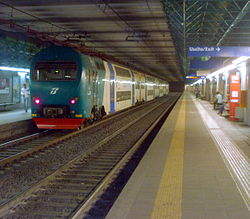Loading AI tools
Railway lines in Lazio From Wikipedia, the free encyclopedia
The FL lines, formerly Lazio regional railways (Italian: ferrovie regionali del Lazio, also Ferrovie Laziali) consist of 8 commuter rail lines operated by Trenitalia, converging on the city of Rome. It operates as a combined suburban railway system that connects the city-centre and the outskirts of the city via a commuter rail line.[2]
| FL lines | |||
|---|---|---|---|
 TAF train at Balduina station | |||
| Overview | |||
| Area served | Rome metropolitan area, Lazio | ||
| Locale | Rome, Lazio | ||
| Transit type | Commuter rail | ||
| Number of lines | 8 | ||
| Number of stations | 131 | ||
| Daily ridership | 286,241[1] | ||
| Website | trenitalia.com | ||
| Operation | |||
| Began operation | 1994 | ||
| Operator(s) | Trenitalia | ||
| Infrastructure manager(s) | Rete Ferroviaria Italiana | ||
| Rolling stock | E.464, TAF, Jazz, ETR 421/521/621 Rock | ||
| Technical | |||
| System length | 672 km (417.6 mi) | ||
| Track gauge | 1,435 mm (4 ft 8+1⁄2 in) standard gauge | ||
| Electrification | 3 kV DC, overhead line | ||
| |||
The FL network, initially made up of two lines and called FM lines (Metropolitan Railways), was formally inaugurated in 1994, following the signing of an agreement between the Lazio Region, the Municipality of Rome, the Province of Rome and Ferrovie dello Stato Italiane, aimed at implementing a new integrated transport structure in the Roman metropolitan and regional area.[3]
Lines FL1, FL2 and FL3 function like a rapid transit service, integrated with the Rome Metro and surface transportation. The other lines (numbered from FL4 to FL8) mostly serve the suburban area of Rome and the Lazio region, and used almost exclusively for commuter traffic.
| Line | Terminals | Year opened | Daily ridership | Length | Stations | Operator |
|---|---|---|---|---|---|---|
| Orte - Fiumicino Aeroporto | 1994 | 65,000 | 118 kilometres (73 mi) | 26 | Trenitalia | |
| Roma Tiburtina - Tivoli | 1994 | 22,000 | 40 kilometres (25 mi) | 13 | Trenitalia | |
| Roma Tiburtina - Viterbo Porta Fiorentina | 1999 | 60,000 | 88 kilometres (55 mi) | 28 | Trenitalia | |
| Roma Termini - Frascati / Albano Laziale / Velletri | 1994 | 55,000 | 24 kilometres (15 mi) / 29 kilometres (18 mi) / 41 kilometres (25 mi) | 20 | Trenitalia | |
| Roma Termini - Civitavecchia | 1994 | 40,000 | 77 kilometres (48 mi) | 14 | Trenitalia | |
| Roma Termini - Cassino | 1994 | 50,000 | 137 kilometres (85 mi) | 22 | Trenitalia | |
| Roma Termini - Minturno - Scauri | 1994 | 40,000 | 137.4 kilometres (85.4 mi) | 13 | Trenitalia | |
| Roma Termini - Nettuno | 2004 | 40,000 | 60 kilometres (37 mi) | 12 | Trenitalia |
All eight lines are considered regional trains by Trenitalia. On timetables and departure boards at the stations the trains are marked with the letter R (Regional). The service timetable is based on a clock-face scheduling.
Sections with one train every 15 minutes:
Sections with one train every 30 minutes:
Sections with one train every 60 minutes:
For travel between stations in the City of Rome, ticketing is integrated with the Metrebus Rome system.[4] A passenger may use the integrated ticket "BIT" from €1,50 (valid for 100 minutes) or any other type of integrated ticket or Metrebus pass; in addition, Trenitalia sells special "Anello" tickets where one may travel on any Trenitalia train within the City of Rome with a single €1 ticket (valid for 90 minutes). The "Anello" and the Metrebus Rome tickets are only valid within Rome, bounded by the stations: Capannelle (FL4 and FL6), Cesano di Roma (FL3), Fiera di Roma (FL1), Lunghezza (FL2), Roma Aurelia (FL5), Settebagni (FL1) and Torricola (FL7 and FL8).
For all trips that take place outside the "Anello" ring, or that cross through the ring, the typical regional mileage rate applies.[1]
Much of the service is operated by double-decker trainsets, usually operating in double formations. The fleet of convoys operating on the network is made up of 388 trains on the entire Lazio railway network,[1] distinguished according to service needs:
Following the upgrading of the Rome railway hub by RFI, new FL stops will be built such as Roma Pigneto, in correspondence with the Pigneto station of the metro, which will be the third busiest railway hub in Rome after Roma Termini and Roma Tiburtina,[6] and track doubling and quadrupling will be implemented on the existing sections as well as technological upgrades for the safety and control of train movement (the implementation of the European Rail Traffic Management System (ERTMS) in the Rome hub is expected by 2024[7]).
In June 2022, 32 years after the 1990 FIFA World Cup, the Valle Aurelia - Vigna Clara route was reactivated with the related Vigna Clara stop, which will be a fundamental part of the so-called "Cintura-Nord" (Northern Belt), whose closure, expected for years, will to complete the Rome railway ring.[8][9]
A year later, in June 2023, the Val d'Ala station was reopened, which is served by some trains of the FL2 line that leave and return from the "Roma Smistamento" depot.
Seamless Wikipedia browsing. On steroids.
Every time you click a link to Wikipedia, Wiktionary or Wikiquote in your browser's search results, it will show the modern Wikiwand interface.
Wikiwand extension is a five stars, simple, with minimum permission required to keep your browsing private, safe and transparent.